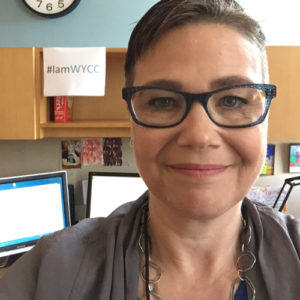-
Featured Expert: Batya Hernandez on Writing Grants That Get Funders’ Attention
- Posted on May 13, 2016
- by Kelly Luchtman
- in Experts Series
- Comments Off on Featured Expert: Batya Hernandez on Writing Grants That Get Funders’ Attention
Batya Hernandez is currently the Assistant Director of Grants and Contracts for WYCC PBS in Chicago. She has specialized in grants management and writing at several social service agencies in the Chicagoland area. She is also an artist and creative writer, and President of the art gallery Blue Line Studio.
I knew Batya as a creative writer, but wasn’t surprised to find out her day job was writing grants, because there really is an art to it. She gave me great tips on writing grants that stand out to funders.
The first thing Batya does is research who funds organizations like hers. Once she narrows it down to several foundations, she drills down. “I take a forensic approach to it. I really breakdown a foundation, I look at their financials, I look at their website. And if they don’t have a website, you have to look at their 990s,” she says. The 990, which is a foundation’s tax return, lists the assets of the foundation, who they funded and at what amount. “And if you look at two or three years of 990s, you can see are they trending up in income or are they trending down,” she says. That trend will help you set a realistic amount for your ask.
Once she determines the foundations she will apply to, she writes the grants, which usually include a summary of what her organization does, a needs statement, and budgetary numbers. When writing grants, Batya uses a story-based approach, making the executive summary and the need statement a pleasure to read. “I try to make it as interesting as possible because I know [the funder] is going to read a hundred proposals on the same subject,” she says. To weave a story in with the facts and numbers required in a grant application, she goes to a service site and watches what happens. For a program that prepares students for kindergarten, she wrote about watching kids cutting and pasting with actual scissors, because cutting helps kids develop the fine motor skills needed to grip a pencil, which is a key activity in Kindergarten.
Batya also incorporates the organization’s strategic plan into the grant. “I’ll do a sustainability paragraph which a lot of grant writers don’t do. For example, my sustainability statement might look like, ‘The program [requiring funding] has been sustained at [the organization] for over 25 years. The current budget is $X. We have committed funders for next year that gets us to 70%. Your contribution would mean a lot to us and it would also help us attract other funders.’ So the strategic plan will talk about programs and program vision and you even have the fundraising goals. That is your roadmap.”
Once the content is finished, she concentrates on the visual style of the grant. She stands firm on using blocked paragraphs, a 12-point font and 1-inch margins. “The page needs to breathe. It needs to look like an article. Those are the things that catch the eye of a funder,” Batya says. Once the application is formatted, she lays it out and looks it over. “I stand up [because] I like to be able to look at the pages spread out. And then I always look for what I can cut out. I know it sounds ridiculous. I’ll take my scissors and I’ll tape how it should go for a better flow.”
And although this should be a given, she stresses how important it is to have someone else proofread the proposal before sending it out. “The devil is in the details.”
It’s easy to get into a rut of writing dry grant applications, especially if your organization doesn’t do “visual” things. But to write a grant that stands out from the crowd, she says, “Keep in mind your reader, and that’s something I learned in fiction writing. Always think about the reader, the audience. You’re taking the audience on a ride.”
If you enjoyed this article please consider sharing it!
Listen to our Customers
“I think it is especially hard to understand what we do, capture it through interviews, and distill it down to 2 minutes, and you hit a home run.”
Ed Jacob as CEO, North Side Community Federal Credit Union May 4, 2015
“How can I ever thank you? You captured the essence of what ASLF is all about.”
Dr. Sandy Goldberg Founder and Chairman, A Silver Lining Foundation May 4, 2015
“It’s all about telling the story and that is what you did so well. The artists had nothing but glowing words about your work and of course, I am thrilled.”
Sydney Sidwell (as Arts & Culture Program Officer at The Joyce Foundation) Associate Director, Ingenuity Incorporated May 4, 2015
“The video was very powerful. I had several people tell me how they were moved to tears by it-including [a featured] artist!”
Michelle T. Boone (as Arts & Culture Program Officer at The Joyce Foundation) Commissioner, City of Chicago Department of Cultural Affairs and Special Events May 4, 2015
Keep in touch with us!
 Please wait...
Please wait...





